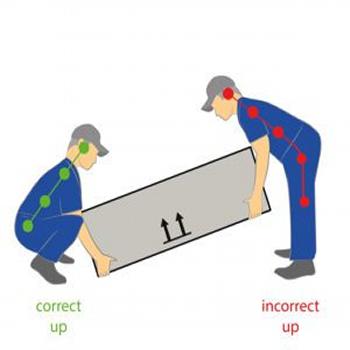Overview of the Level 2 Lift Assessment Evaluation:
Purpose:
- To evaluate an individual’s lifting capacity and biomechanics when handling heavier loads between 75 to 100 lbs.
- To ensure fitness for specific job roles requiring significant manual handling and lifting tasks.
Assessment Protocol:
- The evaluation consists of a series of standardized lifting tasks that simulate real-world lifting scenarios involving heavier objects.
- Participants will lift, carry, and place loads within the specified weight range, utilizing proper lifting techniques.
Key Components of the Evaluation:
- Lift Technique: Assessment focuses on proper lifting techniques, body mechanics, and posture to minimize injury risk.
- Strength Assessment: Measurement of overall muscular strength relevant to lifting heavy objects, including core strength and grip strength.
- Endurance Evaluation: Includes repetitive lifting tasks to evaluate muscular endurance and overall physical capability over time.
- Flexibility Testing: Evaluation of flexibility and range of motion, critical for safe lifting practices.
Scoring and Interpretation:
- Performance is scored based on technique, efficiency, safety during lifting tasks, and overall physical capability.
- Results provide insights into the individual’s readiness to handle heavy lifting, identifying strengths and areas needing improvement.
Benefits of the Evaluation:
- Enhanced Safety: Identifies individuals who may require further training or adjustments to prevent lifting-related injuries.
- Custom Training Programs: Facilitates the development of personalized strength and conditioning programs based on assessment findings.
- Regulatory Compliance: Supports adherence to occupational safety regulations regarding heavy manual handling tasks.
Target Audience:
- Suitable for employees in industries requiring heavy lifting, including manufacturing, construction, shipping, and warehousing.
- Ideal for pre-employment assessments, ongoing employee evaluations, and fitness-for-duty screenings.
Important Considerations:
- Participants should wear appropriate clothing and footwear suitable for physical activity during the assessment.
- A qualified evaluator should supervise the assessment to ensure safety and proper technique throughout the process.
The Level 2 Lift Assessment Evaluation is an indispensable tool for employers focused on enhancing workplace safety and ensuring employees are physically capable of managing heavy lifting tasks. By identifying strengths and addressing potential limitations, organizations can promote a culture of safety and well-being within their workforce.
Why would I need a Level 2 Lift Assessment Evaluation?
The Level 2 Lift Assessment Evaluation is essential for:
Job qualification and hiring: Employers use this evaluation to verify if candidates or employees can lift and manage heavy loads, ensuring that they meet the physical requirements for specific roles.
Injury prevention: The assessment helps identify whether an individual can safely lift heavy weights using proper technique, reducing the risk of strains, sprains, or other injuries.
Return-to-work evaluations: For workers returning to their jobs after an injury, surgery, or medical leave, the lift assessment verifies their readiness to resume heavy lifting duties.
Workplace safety programs: Companies may incorporate this evaluation into their safety initiatives to ensure that employees understand proper lifting techniques and have the necessary strength to perform their tasks safely.
How should I prepare for the Level 2 Lift Assessment Evaluation?
Preparation for the evaluation includes:
Wearing appropriate attire: Wear comfortable, loose-fitting clothing and supportive, non-slip shoes for safe and effective movement.
Warm-up exercises: Before the assessment, perform light stretching or dynamic exercises to prepare your muscles and joints, especially in the legs, back, and arms.
Proper hydration and rest: Being well-hydrated and rested is important to ensure you perform at your best and reduce the risk of fatigue or muscle strain during the assessment.
Informing the evaluator of any health conditions: If you have any injuries or medical conditions that could be affected by lifting, tell the evaluator so they can adjust the assessment accordingly or take additional precautions.
Proper preparation is crucial for performing safely and effectively during the evaluation.
